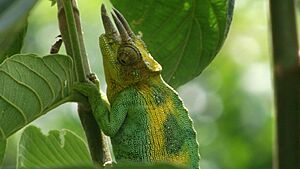Trioceros johnstoni facts for kids
Quick facts for kids Trioceros johnstoni |
|
|---|---|
 |
|
| Male | |
| Conservation status | |
| Scientific classification | |
| Genus: |
Trioceros
|
| Species: |
johnstoni
|
| Synonyms | |
|
|
Trioceros johnstoni, also known as Johnston's chameleon, is a special type of chameleon. It is a lizard from the family called Chamaeleonidae. This chameleon is found only in the high mountains of central Africa. It can grow to be about 30 centimeters (12 inches) long. Only the adult male chameleons have three horns on their heads. Female chameleons do not have these horns.
About Johnston's Chameleon
What's in a Name?
The specific name johnstoni was given to honor a British explorer named Harry Johnston. He was a very important person in exploring parts of Africa.
This chameleon has three long horns. Because of these horns, it looks a bit like other chameleons such as T. jacksonii and T. werneri. However, even though they look similar, they are not closely related. Johnston's chameleon's closest relative is actually a chameleon without horns, called T. ituriensis.
Where Does It Live?
Johnston's chameleon lives in the forests of central Africa. You can find it in countries like the eastern Democratic Republic of the Congo, western Burundi, western Rwanda, and southwestern Uganda. These chameleons prefer to live at high altitudes, between 1,000 and 2,500 meters (about 3,300 to 8,200 feet) above sea level.
They are quite adaptable. They can even live in areas where there are some towns or cities, as long as there are still trees and bushes around for them to hide in.
Behavior and Life Cycle
Male Johnston's chameleons are very protective of their space. They are known to be quite territorial. If another male chameleon comes into their area, they will fight. They use their horns to push and sometimes even bite each other during these fights.
Johnston's chameleons lay eggs. This means they are oviparous. A female chameleon can lay between 4 and 23 eggs at one time. These eggs will hatch later, bringing new baby chameleons into the world.


